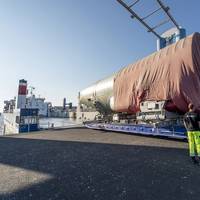First Hybrid Straddle Carriers at Hamburg Port
The port of Hamburg has for the first time introduced two straddle carriers with environmentally friendly hybrid engines.The first two energy saving, low emissions straddle carriers with hybrid engines are being used to transport containers between the ship, the yard, the rail terminal and the truck gate at the HHLA Container Terminal Tollerort (CTT).According to a press release frm the company, the two prototypes are expected to use at least 15 percent less diesel than their predecessors. This will significantly reduce emissions of CO2, nitric oxide and particulate matter.The principle behind the hybrid technology is simple: the straddle carrier stores surplus energy…
HHLA: New Mega-Ship Gantry Cranes Off to a Strong Start
The COSCO Netherlands was the first ship to be processed by the five new container gantry cranes at the HHLA Container Terminal Tollerort (CTT), which are equipped to handle ships with a capacity of more than 20,000 standard containers (TEU). Three of these high-performance gantry cranes have been put into service at Tollerort in the last few days. Two identical gantry cranes have been processing mega-ships at berth 5 since November 2016. On Friday morning, 20 October, the approximately 13,400 TEU-capacity COSCO Netherlands arrived at CTT and left again on Saturday night. During this time, the mega-ship gantry cranes discharged and loaded approximately 7,000 TEU onto the ship.
Terminal Operator HHLA Prepares for Big Vessels
Port of Hamburg terminal operator Hamburger Hafen und Logisitik AG (HHLA) is making further preparations for the latest generation of mega-ships. It has ordered two new container gantry cranes for its Container Terminal Tollerort (CTT), which will be able to handle ships with a capacity of 20,000 standard containers (TEU). HHLA had only just recently ordered three new cranes for HHLA Container Terminal Burchardkai. The ultra-modern container gantry cranes for CTT will be supplied by the Liebherr Company and produced in Germany and Ireland. Dr. Stefan Behn, member of the Executive Board of Hamburger Hafen und Logistik AG, emphasizes the strategic significance of the decision: “We are systematically preparing ourselves for the ever increasing number of ultra large vessels.
200th Airbus A320 Shipset Loaded for China

The 200th shipset for Airbus’s A-320 final assembly line (FAL) in Tianjin, China, was loaded on to the containership COSCO Hope at HHLA’s Container Terminal Tollerort on July 28 and dispatched onwards to Asia. Transport by sea to Tianjin lasts around 40 days. Four ‘shipsets’ per month are transported by containership from the Port of Hamburg to Tianjin. The forward and rear fuselages, tailplane and rudder, the main landing gear doors and the inner landing flaps are each transported by a special transport craft from Airbus pier in Finkenwerder to HHLA Container Terminal Tollerort.
Advances in CAD and CAM System Integration
Over the past 25 years CAD and CAM have become a vital part of shipbuilding. The individual tools have evolved into highly capable products of today. This has included the change from 2-D to 3-D CAD, a dramatic increase in the level of usability (example: from batch mode to fancy 3-D GUI's) and increased functionality within the tools themselves. With the development of these tools has also come improved integration of the CAD and CAM data. While 2-D CAD drawings were originally entered into the CAM system manually, it has now become commonplace to utilize a fully integrated product model environment from vendors such as Dassault Systems (Catia), Intergraph (ISDP), Nupas-Cadmatic, Sener (Foran) and Tribon Solutions (Tribon M1).
Advances in CAD and CAM System Integration
Over the past 25 years CAD and CAM have become a vital part of shipbuilding. The individual tools have evolved into highly capable products of today. This has included the change from 2-D to 3-D CAD, a dramatic increase in the level of usability (example: from batch mode to fancy 3-D GUI's) and increased functionality within the tools themselves. With the development of these tools has also come improved integration of the CAD and CAM data. While 2-D CAD drawings were originally entered into the CAM system manually, it has now become commonplace to utilize a fully integrated product model environment from vendors such as Dassault Systems (Catia), Intergraph (ISDP), Nupas-Cadmatic, Sener (Foran) and Tribon Solutions (Tribon M1).





